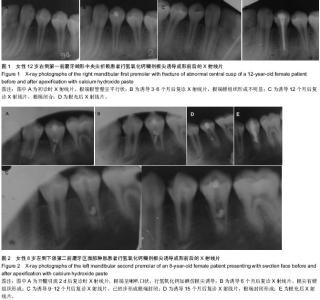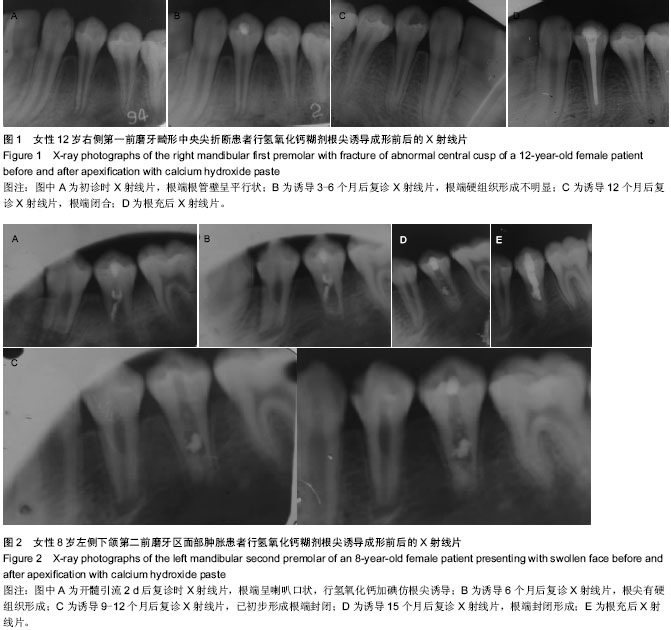| [1] Levitan ME,Himel VT.Dens evaginatus: literature review, pathophysiology, and comprehensive treatment regimen.J Endod.2006;32(1):1-9.
[2] Sakiyama Y. Considerable supplement on the central cusp in the lower second molar. Kaibogaku Zasshi.2001;76(4): 407-410.
[3] Rafter M.Apexification: a review. Dent Traumatol.2005;21(1): 1-8.
[4] Chhabra N,Singbal KP,Kamat S.Successful apexification with resolution of the periapical lesion using mineral trioxide aggregate and demineralized freeze-dried bone allograft.J Conserv Dent.2010;13(2):106-109.
[5] Corbella S,Ferrara G,El Kabbaney A,et al.Apexification, apexogenesis and regenerative endodontic procedures: a review of the literature. Minerva Stomatol. 2014;63(11-12): 375-389.
[6] Ghosh S,Mazumdar D,Ray PK,et al.Comparative evaluation of different forms of calcium hydroxide in apexification. Contemp Clin Dent.2014;5(1):6-12.
[7] Strom TA,Arora A,Osborn B,et al.Endodontic release system for apexification with calcium hydroxide microspheres.J Dent Res.2012;91(11):1055-1059.
[8] Damle SG,Bhattal H,Loomba A.Apexification of anterior teeth: a comparative evaluation of mineral trioxide aggregate and calcium hydroxide paste. J Clin Pediatr Dent.2012;36(3): 263-268.
[9] 聂二民,陈霞云,张春元,等.四种不同氢氧化钙制剂对畸形中央尖患牙的根尖诱导[J].中国组织工程研究,2013,17(8):1398-1403.
[10] 葛立宏.儿童口腔医学[M].4版.北京:人民卫生出版社,2012.
[11] Pochapski MT,Santos FA,de Andrade ED,et al. Effect of pretreatment dexamethasone on postendodontic pain. Oral Surg Oral Med Oral Pathol Oral Radiol Endod. 2009;108(5): 790-795.
[12] Tsurumachi T,Suguro H,Ogata H,et al.Endodontic treatment of bilateral dens evaginatus premolars with large periapical lesions.J Oral Sci.2009;51(3):475-479.
[13] 陈霞云,聂二民,张春元,等.氢氧化钙糊剂预防根管预备封药后的疼痛[J].中国组织工程研究,2012,16(47):8760-8764.
[14] Arslan H,Topcuoglu HS,Aladag H.Effectiveness of tenoxicam and ibuprofen for pain prevention following endodontic therapy in comparison to placebo: a randomized double-blind clinical trial.J Oral Sci.2011;53(2):157-161.
[15] Mehrvarzfar P,Abbott PV,Saghiri MA,et al.Effects of three oral analgesics on postoperative pain following root canal preparation: a controlled clinical trial.Int Endod J.2012;45(1): 76-82.
[16] Wells LK,Drum M,Nusstein J,et al. Efficacy of Ibuprofen and ibuprofen/acetaminophen on postoperative pain in symptomatic patients with a pulpal diagnosis of necrosis.J Endod.2011;37(12):1608-1612.
[17] Arslan H,Topcuoglu HS,Aladag H.Effectiveness of tenoxicam and ibuprofen for pain prevention following endodontic therapy in comparison to placebo: a randomized double-blind clinical trial.J Oral Sci.2011;53(2):157-161.
[18] Tatsuta CT, Morgan LA, Baumgartner JC, et al. Effect of calcium hydroxide and four irrigation regimens on instrumented and uninstrumented canal wall topography. J Endod.1999;25(2):93-98.
[19] Gan N,Yin SH,Zou L,et al.Study of apical diffusion of three different kinds of calcium hydroxide preparations in vitro.Shanghai Kou Qiang Yi Xue.2007;16(5):523-526.
[20] Liu H,Zhou Q,Qin M.Mineral trioxide aggregate versus calcium hydroxide for pulpotomy in primary molars.Chin J Dent Res.2011;14(2):121-125.
[21] Fulzele P,Baliga S,Thosar N,et al. Evaluation of calcium ion, hydroxyl ion release and pH levels in various calcium hydroxide based intracanal medicaments: An in vitro study. Contemp Clin Dent. 2011;2(4):291-295.
[22] Wanees Amin SA,Seyam RS,El-Samman MA.The Effect of Prior Calcium Hydroxide Intracanal Placement on the Bond Strength of Two Calcium Silicate-based and an Epoxy Resin-based Endodontic Sealer.J Endod.2012;38(5):696-699
[23] Vilela DD,Neto MM,Villela AM,et al.Evaluation of interference of calcium hydroxide-based intracanal medication in filling root canal systems.J Contemp Dent Pract. 2011;12(5): 368-371.
[24] 曲柳,杭晓东.Vitapex 糊剂、AH-Plus 糊剂的根尖封闭性研究[J].牙体牙髓牙周病学杂志,2007,17(7):414.
[25] Larsen MJ, Hǎrsted-Bindslev P. A laboratory study evaluating the release of hydroxyl ions from various calcium hydroxide products in narrow canal-like tubes. Int Endod J. 2000;33(3): 238-242.
[26] Wang S. The comparison of performance between calcium hydroxide and metapex root canal filling materials in apexification of young permanent teeth. Shanghai Kou Qiang Yi Xue.2002;11(4):382-384.
[27] Sheehy EC,Roberts GJ.Use of calcium hydroxide for apical barrier formation and healing in non-vital immature permanent teeth: A review. Br Dent J.1997;183(7):241-246.
|

